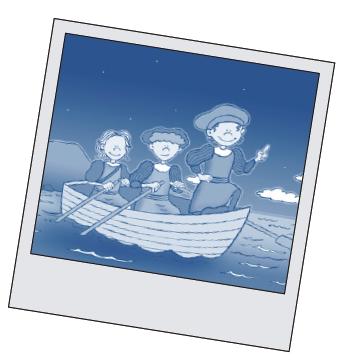Everything Kids' Astronomy Book (2 page)

Imagine what your friends would say if you announced that a god lived on the moon and made the moon increase in size when it rose above the horizon and then made it shrink when it was high in the sky. Can you think of other myths you could tell each other? It does seem almost more like a story than something real, when you think about a universe born billions of years ago. Although the universe has been around for a long time, scientists think it may have formed very fast. Because the universe is constantly expanding, even the best experts can only guess how big the universe is or what shape it may be. Traveling millions and millions of light years to find the answers may take some time, but technology is getting us closer and closer each day. How big or what shape do you think the universe is?
Going Backwards?
Scientists call the start of the universe “The Big Bang.” What do they call the theory that when the universe ends it will collapse in on itself? To learn this name, color in the letters that are not Z, Y, or X. Then read the dark letters from left to right, and top to bottom.

WORDS to KNOW
ASTRONOMY
: Astronomy is the study of all things in space. The people who watch the skies for new stars or planets or changes in the ones that have already been discovered are called astronomers. Astronomy is a type of science.
The Big Picture
One way to see the world from a bird's-eye view is to visit a Web site that shows your town and house from space. At Web sites such as
www.terrafly.com
, you can view your house from the sky! The picture starts out above your town like a bird or the pilot of a plane might see it. As the picture zooms in closer, you can see each house and the cars parked close by. To see this type of aerial map you can type in the words “aerial map” into your search box. Many of the sites offer you a chance to zoom in from space to your neighborhood or school. Another way to imagine how big the universe is would be to take a map of your country and mark where you live on the map with a piece of chalk. Although your town may seem large to you, on most maps that cover large areas it will just be a dot. In a map of the universe, our planet would also be a small dot.
How Big Is Big?
Astronomers figure that the universe has about 100 billion galaxies. If each galaxy has 100 billion stars, that adds up to a HUGE numberâ10 sextillion stars! Think about it this way: Ten thousand is a 10 followed by three zeroes, and ten million is a 10 followed by six zeroes. To find out how many zeroes are in 10 sextillion, break this number substitution (A=1, B=2, etc.) code.

Try This
Glow-in-the-Dark Galaxy
You can make your own spiral galaxy using a pinwheel and painting glow-in-the-dark or glitter paint on the top edges of each blade. Once it is dry, blow on the wheel to see how a spiral galaxy moves. If you used glow-in-the-dark paint, try it in a dark room. This is how our galaxy would look to someone out in space.
Countless Galaxies
Have you ever seen the Milky Way? This collection of stars can be seen all over the world; it looks like a ring of milk spilled across the sky. It is a small part of Earth's own Milky Way Galaxy, which contains billions of stars, and you can see it with your own two eyes. If you could see it from another galaxy, it would look like a pinwheel that rotates every couple of hundred million years. Other galaxies may look like a racetrack or a splatter of paint. Did you know that if someone gave you a penny and then doubled that amount each day, you would soon have more money than you could ever spend? The same is true for our galaxies; there are just too many to be counted.
Sailing, Sailing
The Milky Way Galaxy and other galaxies in the universe display many of the bright stars that sailors in ancient times used like the map your family uses when you go on vacation. These early stargazers were the first people to practice astronomy; they were studying the universe, although they could only see the brightest stars and a few of the planets. Today, sailors can travel over the seas using instruments that focus on the stars to guide them. If you are lucky enough to know someone that sails a boat, ask if they will show you how their instruments work.

WORDS to KNOW
GALAXY:
A galaxy is a group of stars out in space. There are numerous galaxies in the universe. The galaxy we live in is a spiral galaxy. Galaxies can come in different shapes and sizes.
In the Neighborhood?
You may have heard of the Andromeda Galaxy, because it is fairly close to Earth, less than three million light years away. It can be seen without using binoculars on a clear night! Check your friends' knowledge of astronomy. Ask if they have ever heard of the two dwarf galaxies that can only be seen if you are in the Southern Hemisphere. They are known as the Large and Small Magellanic Clouds and seem to be held in place by the Milky Way's gravity! All of these galaxies, including the Milky Way, are part of what is known as the Local Group. Visit your local library and see how far away some of the distant galaxies would be! Weren't you surprised how many were scattered throughout the universe?
A Closer Look
Like the early astronomers, you may need to practice moving your binoculars closer or farther away from your eyes until you can see clearly. If you know someone who owns a pair of binoculars, ask them if they will let you look through them in the daytime. Can you see a street sign or a building that is far away from you? What is the smallest thing that you can recognize?

Round and Round They Go
Do you ever say the sun is “coming up”? It really does seem like the sun is traveling around our earth. The Greek astronomer, Ptolemy, thought the same thing almost 2,000 years ago; many centuries later, a stargazer named Copernicus claimed that our planet really circled or made an orbit around the sun! Each month you can see the shape of the moon change, but around 400 hundred years ago, a famous astronomer called Galileo was watching the changing shape of the planet Venus! This proved to him that it did revolve around the sun. You can go on the Internet and find pictures of Venus and learn when it would be the best time to view this phenomenon. Sometimes you can see it by using only a pair of binoculars. You probably already knew that the planets circle around the sun and that many of them have moons and rings that circle around them. But, did you know that our sun circles around the center of our galaxy? With so many things moving around here on Earth and out in the universe it is amazing so few things collide.
Just for Fun
The Revolving Game
To do this activity you will need several children to be planets and moons. One person can be Earth, another will be the moon, another will be the sun, and others will be the other planets. Once you have everyone in place, start revolving. (The sun stands in the center, the planets spin and revolve around the sun, and any planets' moons revolve around them.) Remember that Earth will be spinning at the same time it is circling the sun. Now try trading places and do it again.
Observing Other Worlds
Do you like to take trips? Everyone likes to see what's beyond the curve in the road, over the top of the hill, or like Christopher Columbus, over the next horizon. Although you can't really visit them, now that you know about all these interesting planets, moons, and galaxies, wouldn't it be fun to take a closer look at them? Many cities have observatories that magnify what you can see with your eyes or binoculars and they welcome visitors. Maybe you have a smaller version of one of them in your hometown. If you can't do either of these things, look at a calendar, one that shows the full and little crescent moons. See when the moon will be dark; it's also called the new moon, because this is the best time to look at the stars and the galaxies. Make sure there are few clouds. Try to find a place where there aren't any streetlights. Then gather up some of these things you may want for your own sky-watching kit:
⢠A blanket, so that you can sit or lie down
⢠A set of binoculars, but try using only your eyes at first
⢠A compass to help you to find the North Star
⢠A pen and paper, so you can write down the stars you find
⢠Some snacks
See if you can borrow a star map from a grownup, so that you know where to begin to look for the stars. If you use a flashlight, the bright light may make it hard for you to see the stars after you turn it off, so be sure to cover the lens with red plastic wrap. Invite some friends and your family to go along, so they can enjoy the fun!
Which One?
Sir Isaac Newton first discovered
the mystery of
gravity when I almost fell on
his head while he was sitting
under a tree.
Which one
am I?
A. Orange
B. Acorn
C. Walnut

What Goes Upâ¦
Have you heard the story about Isaac Newton and the apple that almost struck him as it fell to the ground? He wondered why it didn't remain in the air or even go up into the sky! Newton called the force that pulled the apple to the ground gravity.
